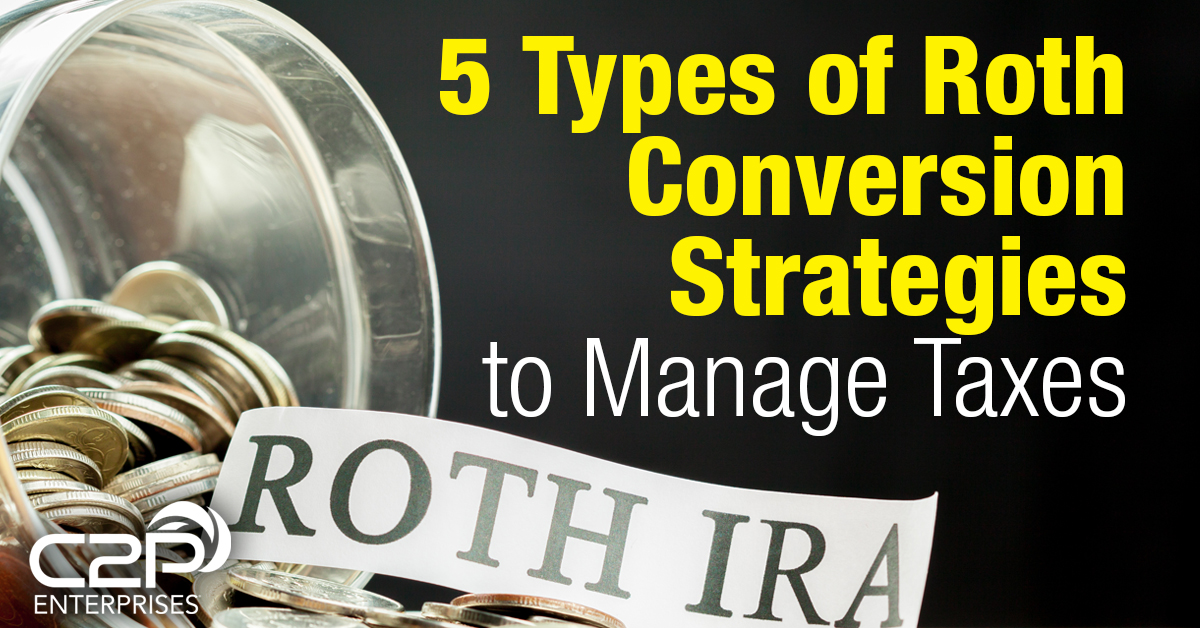[ad_1]
What are the 5 Types of Roth Conversion Strategies?
Did you know that the correct Roth conversion strategy can have a significant impact on how much your clients will pay in taxes over the course of their lifetime?
Taking advantage of the tax benefits provided by Roth conversion strategies can save your clients on taxes, putting more money back into their retirement.
Roth accounts offer tax-free income in retirement without required minimum distributions. When determining the taxation of Social Security benefits or if higher Medicare premiums apply, it isn’t included in the income calculations.
The 5 types of Roth conversion strategies are:
-
Bracket-Bumping Conversion
-
Market-Timing Roth Conversion
-
Back-Door Roth Conversion
-
Mega Back-Door Roth Conversion
-
SEP IRA to Roth Conversion
We expect taxes to be low through 2025, with higher taxes potentially soon after. Utilizing strategic Roth conversions over the next few years can create an opportunity to help reduce your clients’ lifetime taxes.
Want to go from forever taxed to never taxed? Contributions to a Roth account are post-tax funds and continue to grow tax-free, so you can keep the government out of your clients’ retirement savings.
When working with clients, be mindful of the tax implications as a whole. It’s common to consider Roth conversion strategies at the end of the year when you have a full understanding of their annual income.
Learn how The Bucket Plan® can help financial advisors increase their profitable business lines.
1. Bracket-Bumping Conversion
A bracket-bumping Roth conversion strategy attempts to keep converted cash within the client’s current tax bracket, so a conversion doesn’t force any of their funds into a higher bracket.
You can lessen the tax blow and make it more manageable for your clients by spreading conversions across several years to decrease overall taxes.
2. Market-Timing Roth Conversion
The best time to take advantage of a Roth conversion strategy is when the market is down, causing the client’s traditional IRA to lose value. If impending changes to the tax laws will negatively impact taxes in
the future, you can help your clients avoid paying more than necessary by making a conversion before the new regulations go into effect.
Sudden market declines may provide a brief conversion window. Time the market so your clients get the most out of their Roth conversion strategies.
Hint: Now is a fantastic time to help your clients take advantage of the market downturn.
3. Back-Door Roth Conversion
Back-door conversions should be reserved for your high-income earners. This allows clients to utilize a Roth IRA to save for retirement, even if their annual income exceeds the maximum allotted amount. There are a number of factors to consider when looking at a back-door Roth conversion.
4. Mega Back-Door Roth Conversion
Mega-back door conversions should also be reserved for your highest-income earners. This is where the client contributes after-tax dollars to a traditional 401(k) through their employer. Then, immediately roll it over to a Roth IRA from their 401(k). There are a number of factors to consider when looking at a mega back-door Roth conversion.
5. SEP IRA to Roth Conversion
A Simplified Employee Pension (SEP) is designated for your clients who are self-employed or small business owners. You can convert this type of retirement account to a Roth IRA, the same as any other IRA. This conversion makes sense if the client expects to be in a higher tax bracket in retirement and wants to take tax-free withdrawals.
How to Use Roth Conversion Strategies to Manage Taxes
The Tax Management Journey® helps differentiate between tax planning, tax preparation, and tax management.
When you build a house, you first need a blueprint or a plan with everything laid out. This is similar to tax planning, whereas tax management is more like the contractors and builders who get the job done. And the person who prepares annual tax returns is comparable to an inspector who comes in on a regular basis to make sure nothing is broken, and everything runs smoothly.
Dave Alison, CFP®, EA, BPC, the President and Founding Partner of C2P Enterprises, CEO of Alison Wealth Management, and creator of The Tax Management Journey®, hosted a recent seminar. In it, he went through each Roth conversion strategy and discussed ways you can adjust your clients’ portfolios to grow their wealth and reduce their tax bill. Click here to watch it on-demand.
Are you optimizing your clients’ portfolios to ensure their taxes are adequately managed and selecting Roth conversion strategies that benefit them? Book a FREE 20-minute consultation with one of our Business Development Representatives to learn how C2P Enterprises can help you get started—no tax background necessary!
For financial professional use only. Not for use with the general public. The contents of this piece include the opinions and projections of Clarity 2 Prosperity, are subject to change, and are for informational purposes only.
The views and opinions expressed herein are the views and opinions of the author and do not necessarily reflect those of Nasdaq, Inc.
[ad_2]
Image and article originally from www.nasdaq.com. Read the original article here.

